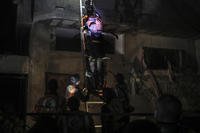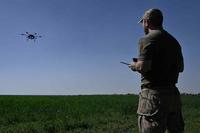The armed services are spending billions and billions to figure out fancy new ways to stop improvised explosive devices, or IEDs. But the latest trick is an oldie -- dating back to World War I -- and couldn't be less high tech. The contraptions are called mine rollers -- sets of wheels mounted in front of a vehicle, basically. When they roll over a mine or a pressure-activated IED, the wheels trigger the bomb. Because the vehicle is some distance behind the rollers, much of the bomb blast wave does not reach the vehicle, dramatically reducing the damage. And the vehicle lives to see another day. The Marine Corps just bought 150 sets from General Dynamics, according to Defense Industry Daily.
The contraptions are called mine rollers -- sets of wheels mounted in front of a vehicle, basically. When they roll over a mine or a pressure-activated IED, the wheels trigger the bomb. Because the vehicle is some distance behind the rollers, much of the bomb blast wave does not reach the vehicle, dramatically reducing the damage. And the vehicle lives to see another day. The Marine Corps just bought 150 sets from General Dynamics, according to Defense Industry Daily.
This idea sounds glaringly obvious. So you might wonder why it took the military more than 3 years to put the rollers up. In fact, the idea of a mine roller originated in 1918, to help nascent tanks deal with the anti-tank mines of that era. Many of the earliest IEDs in Iraq were built with anti-tank mines. Why didn't anybody in the Army Engineer School, for instance, make the connection?
Chalk some of it up to military bureaucracy. When it comes to mine-clearance, combat engineers and explosive ordnance disposal techs sometimes have overlapping lines of responsibility. (Which helps fuel an often-bitter rivalry.) At times, who exactly is supposed to develop bomb- and mine-fighting gear has been a blurry question, as well. The Counter-IED Task Force is now supposed to be in charge. But we'll see.
There are several legitimate concerns with the mine rollers that I am not going to mention here. However, my answer to these concerns are: If the insurgents do that, it would make their IEDs more detectable. Moreover, the standoff will interfere with aiming.
A friend and I were working on a similar concept, a Humvee roller attachment. However, we could not find a machinist to build our prototype. Now that I am deployed, we could not continue our commercial venture. One feature of our design was that it was telescoping, meaning that we can vary the distance of the rollers to the vehicle. We can change the distance to respond to changes in IED tactics. Maybe General Dynamics will incorporate the feature into their next run of mine rollers, too.
-- Jimmy Wu
WWI Mine-Mashers to Iraq
© Copyright 2024 Military.com. All rights reserved. This article may not be republished, rebroadcast, rewritten or otherwise distributed without written permission. To reprint or license this article or any content from Military.com, please submit your request here.








